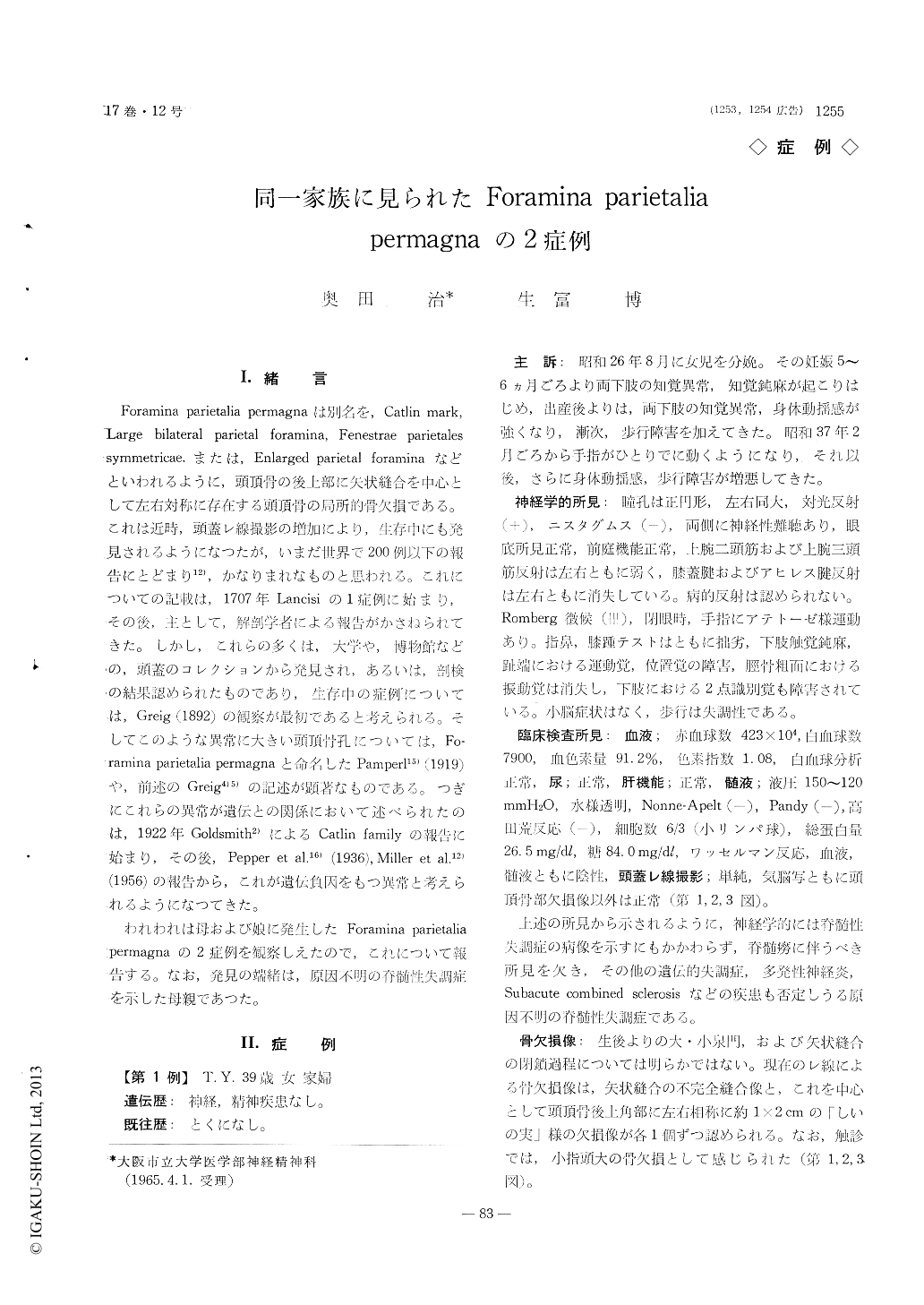Japanese
English
- 有料閲覧
- Abstract 文献概要
- 1ページ目 Look Inside
I.緒言
Foramina parietalia permagnaは別名を,Cat]in mark, Large bilateral parietal foramina, Fenestrae parietales symmetricae,または,Enlarged parietal foraminaなどといわれるように,頭頂骨の後上部に矢状縫合を中心として左右対称に存在する頭頂骨の局所的骨欠損である。これは近時,頭蓋レ線撮影の増加により,生存中にも発見されるようになつたが,いまだ世界で200例以下の報告にとどまり12),かなりまれなものと思われる。これについての記載は,1707年Lancisiの1症例に始まり,その後,主として,解剖学者による報告がかさねられてきた。しかし,これらの多くは,大学や,博物館などの,頭蓋のコレクションから発見され,あるいは,剖検の結果認められたものであり,生存中の症倒について、は,Greig (1892)の観察が最初であると考えられる。そしてこのような異常に大きい頭頂骨孔については,Fo—ramina parietalia permagnaと命名したPamper15),(1919)や,前述のGreig4)5)の記述が顕著なものである。つぎにこれらの異常が遺伝との関係において述べられたのは,1922年Goldsmith2)によるCatlin familyの報告に始まり,その後,Pepper et al.16)(1936),Miller et al.12)(1956)の報告から,これが遺伝負因をもつ異常と考えられるようになつてきた。
われわれは母および娘に発生したForamina parietalia permagnaの2症例を観察しえたので,これについて報告する。なお,発見の端緒は,原因不明の脊髄性失調症を示した母親であつた。
Two cases of Foramina Parietalia Permagna after Pamperl, i. e. bilateral enlarged parietal foramen at the upper angles of the parietal bones were reported. The first case is 39 years old who have suffered from spinal ataxia, and the second case is her 11 years old apparently healthy daughter.
These defects were symmetrically located on each side of the posterior one-third of the sagittal suture on the parietal bone and irregularly shaped with well defined margins, having the diameter of about 1×2 cm in the first case and of about 2.5×3 cm in the second.
The location of these abnormal foramen of the parietal bone exactly corresponds to that of the parie-tal foramen which, during the course of the postnatal development, provides a pin-hole opening for the pas-sage of the parietal emissary vein. Thus, it is conceiv-able that these defects of the parietal bone might be resulted from the abnormal processes of the ossifica-tion, and not related to any disease which causes the thinning of the skull.
Familial occurrence of the cases reported here strong-ly suggests that the hereditary factor might play an important role for the causation of this anomaly. Aetiology of the spinal ataxia seen in the first case is suspected to be due to the systematic degenerative processes. However, the causal relationship between the condition and the anomaly of the skull is un-known.

Copyright © 1965, Igaku-Shoin Ltd. All rights reserved.


